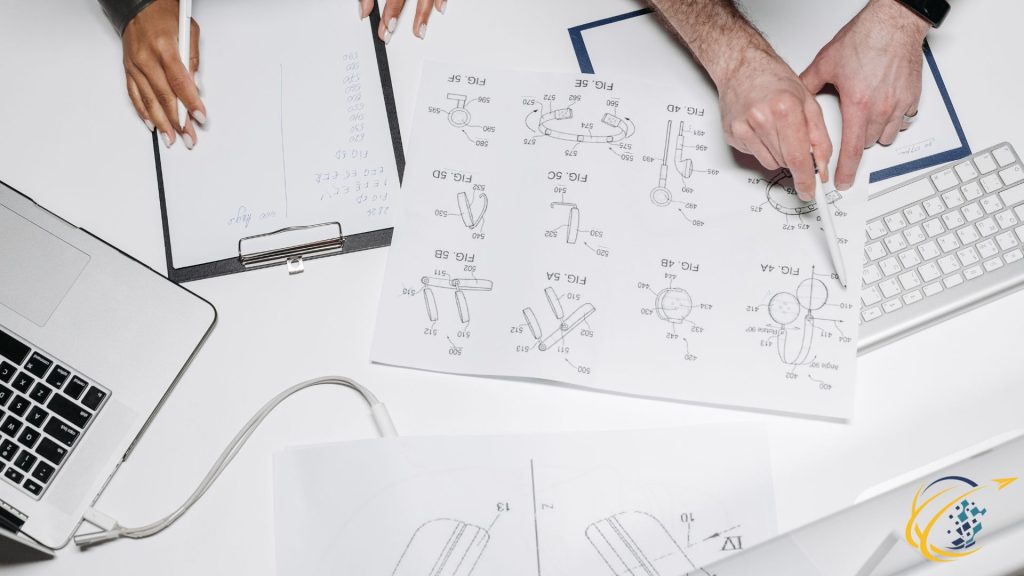Navigating product design and development is crucial for businesses launching innovative products. This journey from concept to consumer involves structured, interdependent stages. Each stage is vital for meeting the product’s functional objectives and market expectations. Understanding each step, from market research to rigorous testing, is essential. This guide explores the core elements of the product design and development process. It emphasizes an iterative approach and continual feedback to refine the product. Engaging in this comprehensive process equips businesses to deliver products that are functional, appealing, and competitive.
Concept Development and Prototyping
Concept development and prototyping are critical stages in the product design and development process. This serves as the creative backbone where we transform ideas into tangible solutions. The journey begins with brainstorming sessions, where diverse teams collaborate to generate a wide array of ideas. These sessions thrive on open communication and a no-judgment approach to encourage creativity and a broad spectrum of ideas.
Following brainstorming, we take the most promising ideas forward through sketching. This step allows designers to visualize concepts, exploring different forms and functions in a quick and cost-effective manner. Sketching not only brings ideas to life but also facilitates easier communication and refinement of these concepts among team members.
The next pivotal step is developing prototypes. Prototyping is essential because it bridges the gap between the conceptual and the tangible. Creating a prototype allows the team to test and interact with their concepts. This provides invaluable insights that are often not apparent in sketches. It enables designers and engineers to assess the practicality of their ideas. They can then iteratively refine their designs based on real-world feedback.
Furthermore, prototyping helps in identifying potential manufacturing issues early in the design process. This saves time and resources in the long run. It could be a simple foam model or a more sophisticated 3D-printed prototype. Nevertheless, each version should refine the product to meet user expectations and functional requirements more closely.
Incorporating these practices into the product design and development process ensures that the final product is not only innovative but also practical and user-centric. Prototyping, in particular, is indispensable. It significantly reduces the risk of product failure by allowing for adjustments based on actual user interaction before final production.
Design Tools and Technology
In the realm of product design and development, the integration of advanced tools and technologies has revolutionized the way we conceive, design, and bring products to market. Among these tools, Computer-Aided Design (CAD) software stands out for its critical role in 3D modeling. CAD enables designers to create precise geometrical representations of objects. This can be manipulated and tested under various conditions without the need for physical prototypes.
Additionally, the advent of Artificial Intelligence (AI) in product design has introduced capabilities for automated design iterations, predictive analytics, and enhanced customization. AI algorithms can rapidly generate design alternatives based on specific parameters. It can also learn from each iteration to improve the outcomes. This significantly speeding up the design process and reducing human error.
3D printing technology allows for rapid prototyping, complex designs, and direct manufacturing of final products in some cases. This technology supports a more agile design process by enabling quick feedback and iteration cycles. This reduces the time and cost associated with traditional manufacturing methods.
Moreover, new technologies such as virtual and augmented reality are becoming increasingly prevalent in product design. These tools offer immersive experiences that allow designers and stakeholders to visualize and interact with 3D models in real-time environments. This interaction can lead to more informed decisions and innovative products that better meet consumer needs.
Overall, the convergence of these technologies within the product design and development process enhances efficiency. It also fosters creativity and innovation, allowing designers to push the boundaries of what is possible. By embracing these tools, companies can stay competitive in a rapidly evolving market. This ensures that their products not only meet but exceed the dynamic expectations of modern consumers.
Testing and Validation
Testing and validation are critical stages in the product design and development process. It ensures that the final product meets the necessary functional, compliance, and user satisfaction criteria. Effective testing of prototypes involves a combination of user testing and technical testing, each serving distinct yet complementary purposes.
User testing primarily focuses on the product’s usability and the end-user experience. It involves real users interacting with the prototype to identify any usability issues or areas for improvement. Techniques such as usability testing sessions, where participants are observed using the product in controlled environments, or beta testing, where a version of the product is released to the public to gather broader feedback, are commonly employed. This form of testing is invaluable as it provides direct insights into how consumers will interact with the product, highlighting practical and aesthetic improvements.
On the technical side, testing involves rigorous checks to ensure the product performs according to its specifications under various conditions. This includes stress testing, where the product is subjected to extreme conditions to test its durability and reliability, and compliance testing, which verifies that the product meets all relevant industry and safety standards. Ensuring technical soundness is crucial not only for the product’s market viability but also for maintaining brand integrity and consumer trust.
Incorporating both user and technical testing in the prototype phase allows for iterative refinements, enhancing product quality before mass production commences. This dual approach reduces the risks of product failures and costly recalls once the product is launched. Thus, a thorough and methodical testing regime is essential to the successful outcome of the product design and development process, ensuring that the product not only functions as intended but also meets the expectations and needs of its users.
Iterative Design and Feedback Integration
The iterative design and feedback integration are fundamental aspects of the product design and development process. This approach emphasizes continuous improvement through a cycle of designing, prototyping, testing, analyzing feedback, and refining the product. By repeatedly refining the product, designers can enhance its functionality and user experience, ensuring it meets or exceeds customer expectations.
Initially, a prototype is created based on the original design concepts, which is then subjected to a series of tests. These tests can vary from user-focused evaluations to measure usability and satisfaction, to technical assessments that ensure the product performs as required under various conditions. Feedback from these tests is critically analyzed and used to identify any changes needed.
Subsequently, the design is adjusted and refined based on this feedback. This might involve tweaking the ergonomics of the product to improve user comfort, altering the design to enhance aesthetic appeal, or upgrading materials to increase durability. Each iteration of the product is tested again, generating new data that feeds back into the design process.
Moreover, this iterative process allows for flexible adaptation to new discoveries and changing market demands. As we continuously incorporate feedback, the product gradually evolves, with each version improving upon the last. This method not only improves the quality of the final product but also reduces the risk of costly post-launch failures and recalls.
Adopting an iterative approach within the product design and development process ensures that the final product is not only technically sound but also aligns closely with user needs and preferences. By placing a strong emphasis on feedback integration, companies can create products that genuinely resonate with their target market, enhancing customer satisfaction and fostering brand loyalty.
Conclusion
In conclusion, the product design and development process encompass a series of crucial steps that transform a concept into a market-ready product. Starting with understanding user needs and market research, moving through concept development and prototyping, leveraging advanced design tools and technologies, and conducting thorough testing and validation—each phase plays a vital role in shaping the final product. The iterative nature of the design process, enriched with continuous feedback integration, further ensures that the product not only meets technical specifications but also aligns with consumer expectations and preferences. By meticulously navigating these stages, businesses can enhance product functionality, improve user experience, and ultimately achieve a successful product launch. This comprehensive approach not only minimizes the risk of failure but also paves the way for innovations that can disrupt markets and drive business success.


